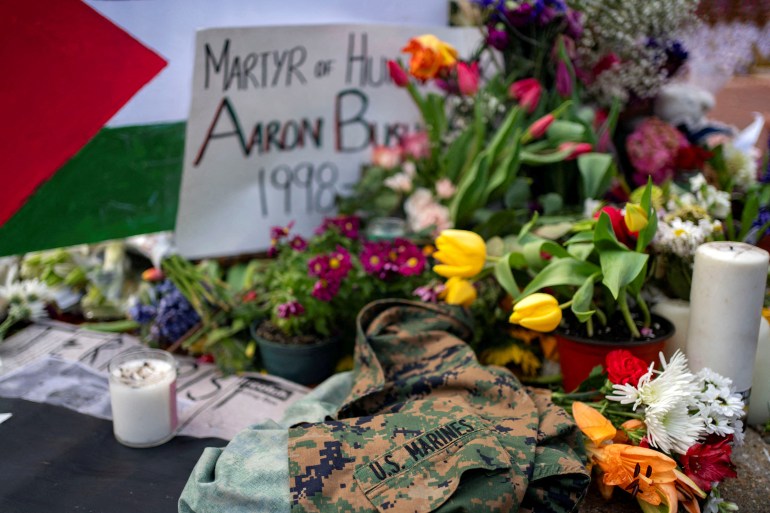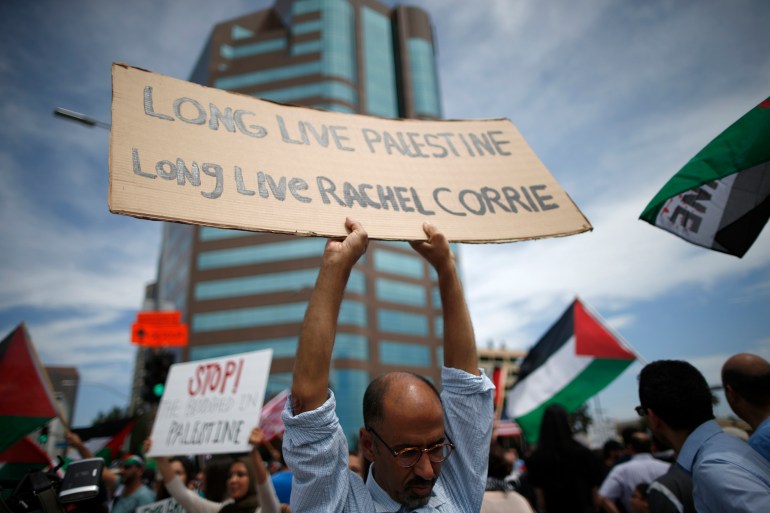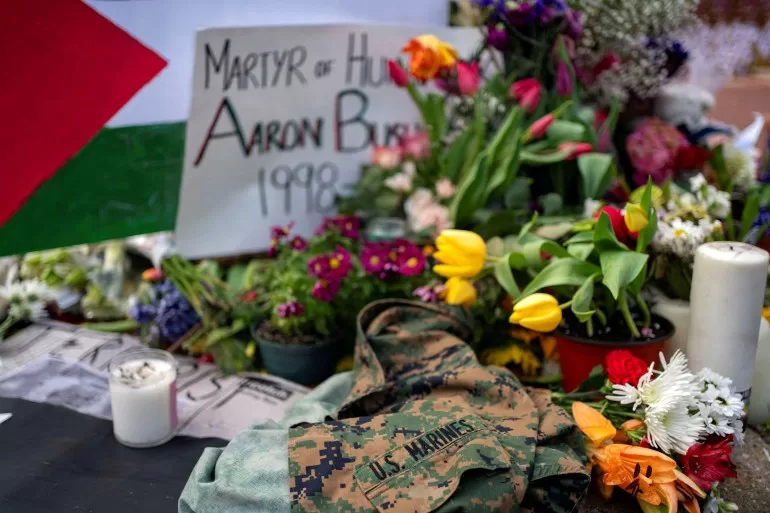“At two o’clock on the afternoon of Sunday, March 16, Rachel Corrie received a cell-phone call from a comrade in the International Solidarity Movement. ‘The Israelis are back,’ she told Corrie. ‘Get over here right away. I think they’re heading for Dr. Samir’s house.’ The news alarmed Corrie. Samir Nasrallah was a Palestinian pharmacist who lived with his wife and three children a few hundred yards from the battle-scarred Egyptian border in the Gaza Strip town of Rafah. Corrie and other pro-Palestinian activists based in Rafah had frequently spent the night in Nasrallah’s house, acting as human shields against the Israeli tanks and bulldozers, clearing a security zone around the border. Almost every other structure in the area had been knocked down in recent months; Nasrallah’s abode now stood alone in a sea of sand and debris.
Certain that the pharmacist’s house was about to be razed, Corrie caught a taxi to the Hai as-Salam neighbourhood. The paved roads of downtown Rafah gave way to sandy tracks lined with scrabbly olive groves, mosques, modest houses, and dirt pitches where Corrie often played football – badly but enthusiastically – with local youths. At 2:30pm, a neighbour of Nasrallah’s named Abu Ahmed caught sight of the activist hurrying past his house. Slight, hazel-eyed, with high cheekbones and dirty blond hair pulled back in a ponytail, she carried a megaphone in one hand and an orange fluorescent jacket in the other. “Come inside and have some tea,” he urged her. But Corrie told him she did not have time, and he watched as she disappeared around the corner of his house, heading towards the roar of machinery.
This much has never been contested: placing herself in the path of an Israeli bulldozer that she believed was about to flatten Nasrallah’s house, Rachel Corrie was crushed to death—her skull fractured, her ribs shattered, her lungs punctured.”
Witnesses said that Corrie’s death was no accident; the bulldozer’s operator had deliberately run over her, then put the vehicle in reverse.
Palestinians in Gaza hailed her as a “martyr”, holding a massive funeral for her, dedicating an annual football tournament to her memory, renaming a street in the West Bank for her, and building a shrine to her strewn with wreaths and olive branches.
On the fourth anniversary of her death, Palestinian youth activists organised a permanent art exhibit of Corrie’s personal belongings at a government site in Rafah, from which they hung placards that expressed sentiments such as “Rachel Corrie died as a Palestinian” and “We welcome her in the highest esteem and honour.”
Every year, on the anniversary of her death, Arab newspapers commemorate her sacrifice, and Palestinian scholars and diplomats pay homage to her.

‘Sacrificed everything for Palestinians’
In a YouTube video posted Friday, Lowkey, a British hip hop artist of Iraqi ancestry cited Corrie’s death to rebuke narratives that date the current conflict only back to Hamas’ attack on Israeli settlers last year, saying, “Rachel Corrie died as a US citizen defending Palestinian homes in Gaza. . . this didn’t begin on October 7th. Rachel Corrie represented the conscience of humanity. Through her, that basic aversion to watching human suffering was channelled. She gave her life to the Palestinian cause.”
Corrie’s sacrifice has special resonance this year, however, not just because of Israel’s five-month siege and blockade of Gaza, but because of the equally shocking death of Aaron Bushnell nearly three weeks ago.
On the afternoon of February 25, Bushnell, dressed in his US Air Force uniform, livestreamed himself while walking to the Israeli embassy in Washington while calmly declaring his intentions.
“I’m about to engage in an extreme act of protest but, compared to what people have been experiencing in Palestine at the hands of their colonisers, it’s not extreme at all. This is what our ruling class has decided will be normal.”
Once he had reached the front steps outside the embassy, he poured a flammable liquid atop his buzz-cut head, lit himself on fire, and shouted “Free Palestine!” several times before collapsing in a heap onto the pavement.
As was the case following Corrie’s death 21 years earlier, Palestinians and antiwar activists hailed the 25-year-old Bushnell as a “martyr”.
In a statement published on Telegram a few days after his death, Hamas wrote that the US pilot ” immortalised his name as a defender of human values and the oppression of the suffering Palestinian people because of the American administration and its unjust policies”. Continuing, Hamas wrote admiringly of Bushnell’s effort to highlight the “massacres and Zionist genocide” against Palestinians.
Similarly, the mayor of the Palestinian town of Jericho, Abdul Karim Sidr, named a street for Bushnell only days after his death, declaring that he “sacrificed everything” for Palestinians.
“We didn’t know him, and he didn’t know us. There were no social, economic or political ties between us. What we share is a love for freedom and a desire to stand against these attacks [on Gaza],” Sidro told a small crowd assembled on the new Aaron Bushnell Road, which adjoins a street named after the iconic Palestinian poet, Mahmoud Darwish. In Yemen, Bushnell’s image can be seen on billboards across the capital city of Sanaa. And in Portland, Oregon, a group of US military veterans burned their uniforms in a gesture of solidarity with Bushnell.
Jericho City Councilman Amani Rayan, who grew up in Gaza and moved to the occupied West Bank to study when he was a teenager, told the Guardian newspaper: “He [Bushnell] sacrificed the most precious thing, whatever your beliefs. This man gave all his privileges for the children of Gaza.”
In his YouTube video released Friday, Lowkey noted that Bushnell was mocked, just as Corrie was ridiculed as a “pancake” by Israelis following her death. He said: And much in the same way that Rachel Corrie was mocked after his death, we saw an outpouring of fake posts– produced who knows where– so in his death Aaron Bushnell was smeared.”
Although the media in the US has suggested that Bushnell was suffering from depression or mental illness, Lowkey and others point to his words that indicate clearly that the motivation for his self-immolation was his concern for the Palestinians’ plight. In his will, he wrote, “If a time comes when Palestinians regain control of their land, and if the people native to the land would be open to the possibility, I would love for my ashes to be scattered in a free Palestine.”
Said Lowkey, “What Aaron Bushnell and Rachel Corrie were responding to was a political system that has invested in the genocide of Palestinians and they stated their objection to that relationship with their bodies. These are wounds of humanity; these are a testament to the universality of the Palestinian cause. The holding of the picture of Aaron Bushnell from Gaza to Yemen pays tribute to the fact that the Palestinian cause is not a cause for one group of people only; it is a cause for all of humanity.”

A tradition of white allyship
Corrie’s parents say that their daughter calculated – wrongly – that her white skin would protect her in a way that it did not immunize Arabs, although on the same day that she died, nine Palestinians were killed, including a four-year-old girl and a 90-year-old man, with none meriting so much as a mention in the Western news media. Human Rights Monitor reported that, during Israel’s war on Gaza, Israeli tanks have “deliberately” run over several Palestinians defending their homes or land, fatally injuring them. The Western media has largely ignored these deaths.
Commenting on social media in recent weeks, many Americans have noted that questioning the motives of white allies who articulate solidarity with racialised groups is consistent with a US tradition in which the media typically portrays white dissidents – from the abolitionist John Brown to the slain civil rights activists David Goodman and Michael Schwerner – as demented, naive or cynical in an effort to delegitimise resistance movements. Similarly, Viola Liuzzo, a white Detroit housewife who was killed while shuttling African American volunteers registering voters in Selma Alabama – was called a “whore” by some whites and the late director of the Federal Bureau of Investigation, J Edgar Hoover, said that she was having sex with her Black passenger when she was killed.
That signals to supporters of both Corrie and Bushnell that acts of solidarity, especially when it is interracial, jeopardise imperialist projects by beginning to change hearts and minds. At a memorial for Bushnell, Mike Prysner, an Iraqi war veteran, contextualised Bushnell within a long line of soldiers and veterans whose antiwar leadership helped end the war in Vietnam.
“It can again for Gaza,” Prysner said at a memorial for Bushnell.
In an interview, Rabab Abdulhadi, the Palestinian-born associate professor of ethnic studies, race and resistance studies and the founding director of Arab and Muslim ethnicities and diasporas studies at San Francisco State University, noted the proliferation and long history of solidarity movements, from Palestinians supporting Spaniards in the Spanish civil war against Francisco Franco’s fascist regime, the support of Palestinian resistance movements by African American activists such as Malcolm X, and Che Guevara’s visit to Palestine just months after the Cuban revolution toppled the US-backed government of Fulgencio Battista.
In an unpublished 2015 interview with a book author, Bernardine Dohrn, the leader of a radical, far-left organisation, the Weather Underground, said that her activism was inspired by seeing the news coverage of Emmett Till, the 14-year-old Black boy who was murdered by a mob of white men in Mississippi in 1955. She was struck, she said, by the fact that she was the same age as the boy whose mutilated body had been dragged from a swamp.
“It was one of the things that taught me that when white people say they hate violence”, she said, “they don’t really hate violence. What they really mean is that they hate violence against them. The whole idea behind the Weather Underground was, as we stated, to bring the [Vietnam] war home and have white people feel just a fraction of the violence that they were visiting on Black and brown people all over the world.”
The Weather Underground was formed as a response to the state’s assassination of the chairman of the Illinois chapter of the Black Panthers, Fred Hampton, and is part of a tradition of white allies – sometimes violent – who emerged after World War II to provide material support to resistance movements by people of colour, and include the West German organisation, Rote Armee Fraktion (known as The Red Army Faction or the Baader-Meinhof group), as well as white, Jewish anti-apartheid fighters such as Ronnie Kasrils, Ruth First (who was assassinated by apartheid-era security forces) and her husband, Joe Slovo, the head of South Africa’s communist party. So beloved was Slovo, in fact, that his 1995 funeral procession in the all-Black Johannesburg township of Soweto was long regarded as the largest in Soweto’s history until it was surpassed in 2018 upon the death of Winnie Mandela.
While Liuzzo was not as radical as Slovo, she might be as beloved by Blacks in the US as Slovo is by Black South Africans. Watching televised accounts of law enforcement’s savage attack on the more than 500 peaceful, African American protesters marching across the Edmund Pettus Bridge in Selma, Alabama on March 7, 1965, the 39-year-old mother of five was moved to tears while watching Martin Luther King’s televised appeal for people of conscience to help register Black voters, and decided at that moment to heed King’s call and make the trip to Selma in her ’63 Oldsmobile.
Shuttling a Black volunteer from Montgomery to Selma on the night of March 25th, 1965, Liuzzo was accosted by a car carrying four Ku Klux Klan members, and shot dead, her car veering into a ditch.
On the afternoon she left for Alabama, though, her husband, a business agent for the Teamsters, arrived home to find his wife packing a suitcase. He tried desperately to dissuade her from going, but she would have none of it. As she opened the front door to their home to leave, suitcase in hand, he made one final, desperate plea.
“Vi,” he said, “this isn’t your fight.”
“This,” she said, “is everybody’s fight.” And with that, she turned to walk out the door, heading south.
